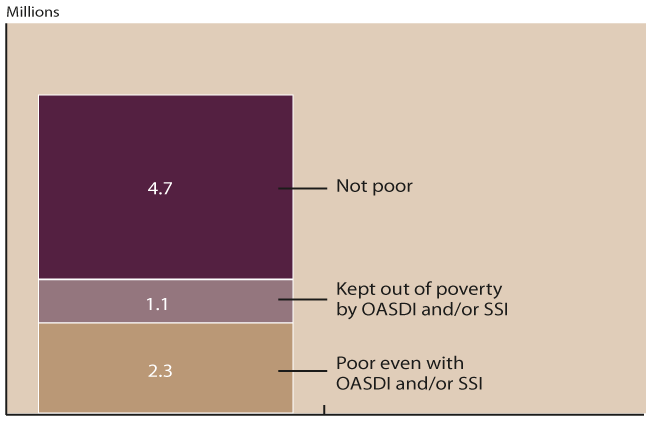Fast Facts & Figures About Social Security, 2000
Did You Know That...
- We served more than 48 million people in 1999
- Social Security benefits were awarded to 3.9 million persons
- Social Security accounted for 38% of total income for aged persons
- Social Security kept 39% of aged persons out of poverty
- Social Security and Supplemental Security Income kept 1.1 million children out of poverty
- Women accounted for 58% of adult Social Security beneficiaries
- The average age of Disability Insurance beneficiaries has fallen from just over 57 in 1960 to 50.6
- Disability was the reason for paying 79% of SSI recipients
Abbreviations
- AIME
- Average Indexed Monthly Earnings
- DI
- Disability Insurance
- HI
- Hospital Insurance
- OASDI
- Old-Age, Survivors, and Disability Insurance
- OASI
- Old-Age and Survivors Insurance
- ORES
- Office of Research, Evaluation, and Statistics
- PIA
- Primary Insurance Amount
- SSA
- Social Security Administration
- SSI
- Supplemental Security Income
General Information, 2000
Tax rates
| Program | Employer and employee, each |
Self-employed |
|---|---|---|
| Total | 7.65 | 15.30 |
| OASI | 5.30 | 10.60 |
| DI | 0.90 | 1.80 |
| HI | 1.45 | 2.90 |
| NOTE: Social Security tax for employers and self-employed can be partially offset under income tax rules. | ||
Average wage index
| Year | Index |
|---|---|
| 1998 | 28,861 |
| 1999 (estimated) | 30,299 |
| 2000 (estimated) | 31,685 |
| SOURCE: Office of the Chief Actuary, SSA. | |
Maximum earnings subject to Social Security taxes
| Program | Amount |
|---|---|
| OASDI | 76,200 |
| HI | No limit |
Taxes payable
| Type of earner | OASI | DI | HI |
|---|---|---|---|
| Average earner | 1,679 | 285 | 459 |
| Maximum earner | 4,039 | 686 | No limit |
| Self-employed maximum earner | 8,077 | 1,372 | No limit |
Quarters of coverage
- $780 in earnings equals 1 quarter of coverage (or 1 credit)
- $3,120 is the maximum earnings needed for 4 quarters of coverage (or 4 credits) per year
Retirement earnings test
| Period | Annually | Monthly |
|---|---|---|
| Under age 65 ($1 for $2 withholding rate) | 10,080 | 840 |
| Calendar year attaining age 65 ($1 for $3 withholding rate) |
17,000 | 1,417 |
| After calendar year attaining age 65 or older |
No limit | No limit |
Age for full retirement benefit
| Full benefit at age— | Applicable to workers who attain age 62 in year— |
|---|---|
| 65 and 2 months | 2000 |
| 65 and 4 months | 2001 |
| 65 and 6 months | 2002 |
| 65 and 8 months | 2003 |
| 65 and 10 months | 2004 |
| 66 | 2005–2016 |
| 66 and 2 months | 2017 |
| 66 and 4 months | 2018 |
| 66 and 6 months | 2019 |
| 66 and 8 months | 2020 |
| 66 and 10 months | 2021 |
| 67 | 2022 and later |
Benefit formula bend points
Benefit formula bend points (for workers who in 2000 attain age 62, become disabled, or die before age 62)
Primary insurance amount equals:
90% of the first $531 of AIME, plus
32% of AIME over $531 through $3,202, plus
15% of AIME over $3,202
Maximum family benefit equals:
150% of the first $679 of PIA, plus
272% of PIA over $679 through $980, plus
134% of PIA over $980 through $1,278, plus
175% of PIA over $1,278
Substantial gainful activity
- Earnings of $700 per month for nonblind disabled persons
- Earnings of $1,170 per month for blind persons
OASDI administrative expenses
Trust fund operations
| Calendar year and program |
Income | Outgo | Fund at end of year |
|---|---|---|---|
| 1999 (actual) | |||
| OASI | 457.0 | 339.9 | 798.8 |
| DI | 69.5 | 53.0 | 97.3 |
| 2000 (estimated) | |||
| OASI | 487.0 | 353.8 | 932.0 |
| DI | 78.7 | 56.5 | 119.5 |
| SOURCE: 2000 Trustees' Report. | |||
Benefit payments
| Calendar year | Total | OASI | DI |
|---|---|---|---|
| 1998 | 4.28 | 3.73 | 0.55 |
| 1999 | 4.17 | 3.62 | 0.56 |
Filings
| Type of filing | Number |
|---|---|
| OASI claims a | 3.1 million |
| DI claims | 1.5 million |
| SSI applications | 1.6 million |
| a. OASI claims exclude those filed by disabled widow(er)s and disabled adult children of retired or deceased workers, which are included in the DI claims. | |
Supplemental Security Income
- $512 for an individual
- $769 for a couple
Poverty thresholds
| Family unit | 1997 | 1998 | 1999 (preliminary) |
|---|---|---|---|
| Aged individual | 7,698 | 7,818 | 7,990 |
| Family of two, aged head | 9,712 | 9,862 | 10,070 |
| Family of four | 16,400 | 16,660 | 17,184 |
| SOURCE: U.S. Census Bureau. | |||
Income of the Aged Population
Size of Income
Median income of aged units, 1962 and 1998
Median annual income for both married couples and nonmarried persons increased markedly from 1962 (the earliest year for which data are available) to 1998. Even after adjusting for inflation, median income rose 95% for married couples and 98% for nonmarried persons.
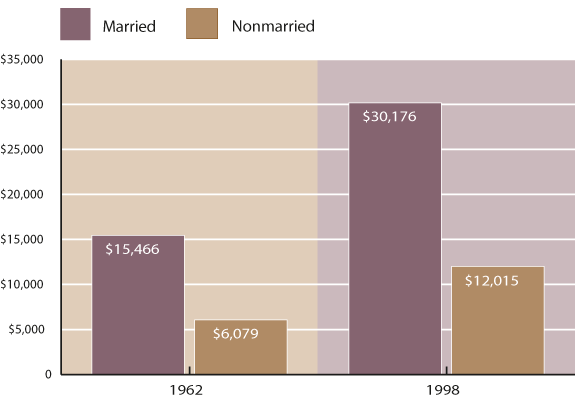
Receipt of Income
Sources of Income, 1962 and 1998
Social Security benefits, which were the most common source of income in 1962, are now almost universal. The proportion of aged units with asset income, the next most common source, has grown from about one-half to nearly two-thirds. Over the 36-year period, receipt of private pensions has more than tripled and receipt of government pensions has increased by over 50%. A smaller proportion of couples and nonmarried persons aged 65 or older received earnings in 1998 than in 1962.
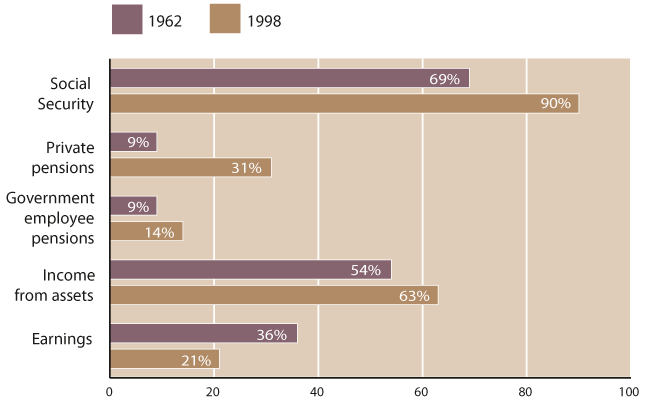
| Source of income | 1962 | 1998 |
|---|---|---|
| Social Security | 69 | 90 |
| Asset income | 54 | 63 |
| Private pensions | 9 | 31 |
| Government employee pensions | 9 | 14 |
| Earnings | 36 | 21 |
Shares of Aggregate Income
Proportion of income from various sources, 1962 and 1998
In 1962, Social Security, private and government employee pensions, income from assets, and earnings made up only 84% of the total income of the aged, compared with 97% in 1998. Although private pensions still accounted for only a small proportion of total income in 1998, they more than tripled their share in the period—from 3% to 10%. The share from earnings declined from 28% to 21%.
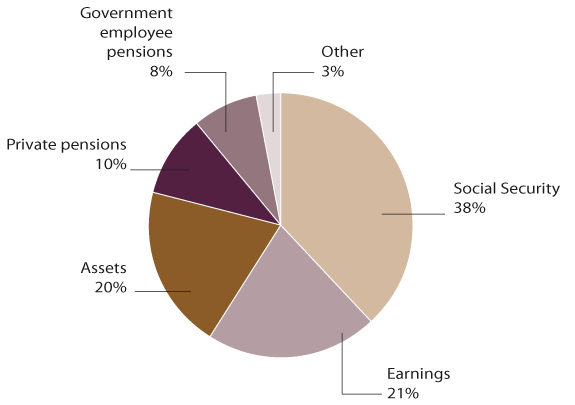
Reliance on Social Security
Importance of benefits, 1998
The OASDI program paid benefits to 90% of those aged 65 or older in 1998. It was the major source of income (providing at least 50% of total income) for 63% of the beneficiary units (couples or nonmarried persons), and it was the only source of income for 18%.
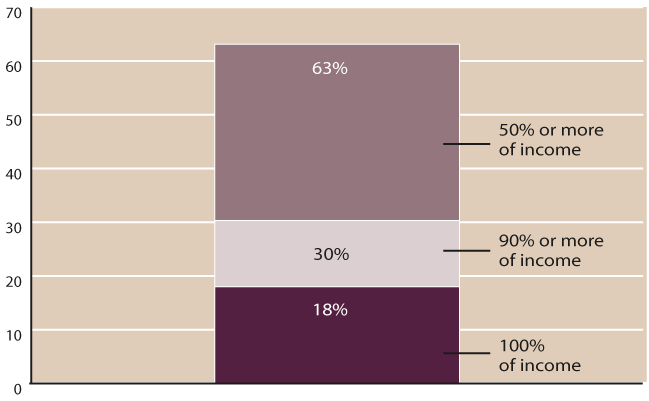
Benefits Affect Poverty
Benefits reduce poverty rates, 1998
About two-fifths of the aged were kept out of poverty by Social Security benefits in 1998, a proportion that varies little by marital status or race. Overall, 9% of aged beneficiaries were poor; without Social Security, the total poverty rate would have been 48%. (Data are based on family income rather than aged person income to conform to official measures of poverty.)
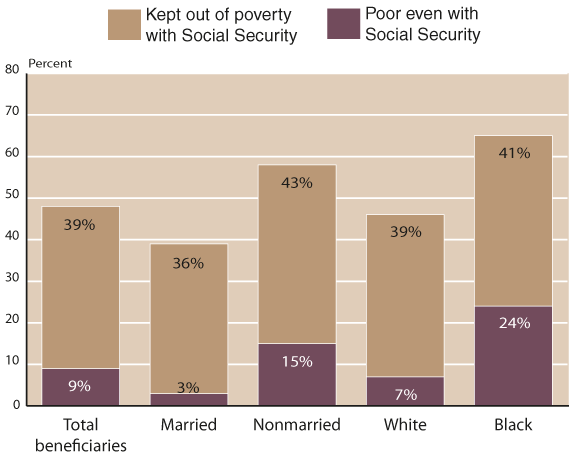
| Characteristic | Poor even with Social Security | Keep out of poverty with Social Security |
|---|---|---|
| Total beneficiaries | 9 | 39 |
| By marital status | ||
| Married | 3 | 36 |
| Nonmarried | 15 | 43 |
| By race | ||
| White alone | 7 | 39 |
| Black alone | 24 | 41 |
OASDI Program
Workers and Insured Status
Workers with taxable earnings, 1937–99
In 1999, 152 million workers had earnings in employment covered by the Social Security program. Of these workers, 6% had earnings that equaled or exceeded the maximum amount currently subject to Social Security taxes, compared with 3% when the program began and a peak of 35% in 1965. About 85% of the earnings of workers in covered employment were taxable in 1999, compared with 92% in 1937.
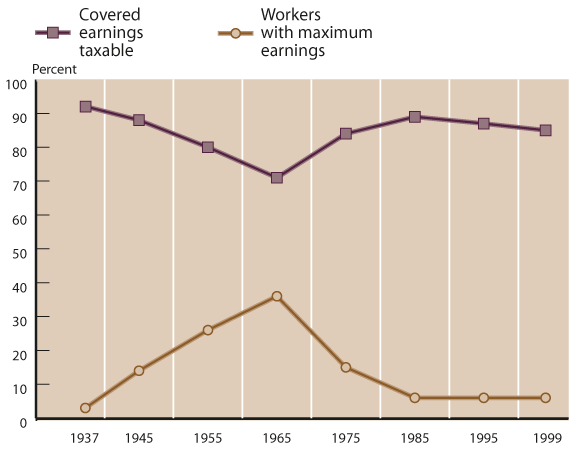
Workers and Insured Status
Insured workers, 1970–2000
Of persons aged 20 or older, the percentage insured for benefits has steadily increased over time. The percent permanently insured (those with enough covered work experience to qualify for retired-worker benefits at retirement age) rose from 50% in 1970 to 69% in 2000. The percentage fully insured increased from 77% to 88%. To be fully insured, a worker must have at least one quarter of coverage for each year elapsed after 1950 (or age 21, if later) and before the year in which he or she attains age 62 or becomes disabled. To be insured for disability, the worker must be fully insured and have at least 20 quarters of coverage during the last 40 quarters. (Requirements for currently insured status are somewhat different for persons younger than age 31.)
| Year a | Population (in millions) b |
Permanently insured |
Fully insured |
Insured for disability |
|---|---|---|---|---|
| 1970 | 135.2 | 50 | 77 | 52 |
| 1975 | 147.5 | 50 | 80 | 54 |
| 1980 | 162.0 | 53 | 83 | 58 |
| 1985 | 175.1 | 57 | 84 | 60 |
| 1990 | 186.0 | 63 | 86 | 62 |
| 1995 | 194.7 | 66 | 87 | 64 |
| 2000 | 204.8 | 69 | 88 | 66 |
| SOURCE: Office of the Chief Actuary, SSA. | ||||
| a. As of December 31. | ||||
| b. The population in the Social Security area includes residents of the 50 states and the District of Columbia; civilian residents of American Samoa, Guam, Northern Mariana Islands, Puerto Rico, and the Virgin Islands; federal civilian employees and Armed Forces abroad and their dependents; crew members of merchant vessels; and all other U.S. citizens abroad. | ||||
Workers and Insured Status
Insured status, by sex, 1970 and 2000
Although men are more likely than women to be insured, the gender gap is shrinking. The proportion of men insured has remained essentially stable, with 93% fully insured and about 73% insured for disability. By contrast, the proportion of women insured has increased dramatically—from 63% to 83% for those fully insured and from 33% to 60% for those insured for disability.

| Sex | 1970 | 2000 |
|---|---|---|
| Fully insured | ||
| Men | 92 | 93 |
| Women | 63 | 83 |
| Insured for disability | ||
| Men | 73 | 72 |
| Women | 33 | 60 |
New Benefit Awards
Benefits awarded, 1999
Benefits were awarded to 3.9 million persons in 1999. Forty-three percent were retired workers and 16% were disabled workers. The remaining 41% were survivors and/or dependents of workers—that is, spouses and children of retired or disabled workers who received benefits based on the worker's earnings record.
| Type of beneficiary | Total number (in thousands) |
Total percent |
|---|---|---|
| New awards | 3,917 | 100 |
| Retired workers and dependents | 2,065 | 52 |
| Workers | 1,690 | 43 |
| Spouses and children | 375 | 9 |
| Disabled workers and dependents | 1,045 | 27 |
| Workers | 621 | 16 |
| Spouses and children | 424 | 11 |
| Survivors of deceased workers | 807 | 21 |

New Benefit Awards
Benefits awarded to workers, 1960–99
Benefits awarded to retired workers have increased considerably since 1960 but proportionately much less than benefits to disabled workers. The patterns of growth have also differed. Retired-worker awards rose steadily during the first half of the period, then leveled off around 1980 and have since declined slightly. Disabled-worker awards increased rapidly until the late seventies, then declined considerably for about a decade, resuming their growth during the nineties.
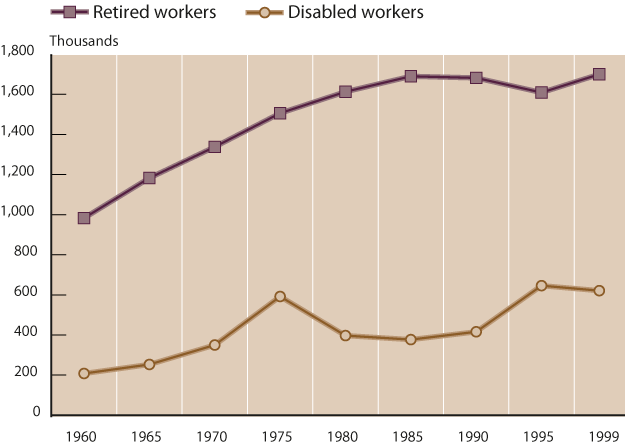
| Year | Retired workers |
Disabled workers |
|---|---|---|
| 1968 | 1200.00 | 323.00 |
| 1969 | 1272.78 | 344.74 |
| 1970 | 1338.11 | 350.38 |
| 1971 | 1391.40 | 415.90 |
| 1972 | 1461.40 | 455.44 |
| 1973 | 1493.19 | 491.62 |
| 1974 | 1413.15 | 535.98 |
| 1975 | 1505.75 | 592.05 |
| 1976 | 1475.77 | 551.46 |
| 1977 | 1593.63 | 568.87 |
| 1978 | 1472.79 | 464.42 |
| 1979 | 1590.85 | 416.71 |
| 1980 | 1612.67 | 396.56 |
| 1981 | 1578.99 | 351.85 |
| 1982 | 1618.41 | 297.13 |
| 1983 | 1669.74 | 311.55 |
| 1984 | 1607.37 | 362.00 |
| 1985 | 1690.49 | 377.37 |
| 1986 | 1734.25 | 416.87 |
| 1987 | 1681.72 | 415.85 |
| 1988 | 1654.07 | 409.49 |
| 1989 | 1656.74 | 425.58 |
| 1990 | 1664.75 | 467.98 |
| 1991 | 1695.35 | 536.43 |
| 1992 | 1707.95 | 636.64 |
| 1993 | 1661.28 | 635.24 |
| 1994 | 1625.35 | 631.87 |
| 1995 | 1609.17 | 645.83 |
| 1996 | 1581.45 | 624.34 |
| 1997 | 1718.62 | 587.42 |
| 1998 | 1631.51 | 608.13 |
| 1999 | 1690.02 | 620.49 |
Benefits in Current-Payment Status
Persons receiving monthly benefits, December 1999
More than 44 million persons were receiving monthly Social Security benefits in December 1999. Of these, the majority were retired workers.
| Type of beneficiary | Total number (in thousands) |
Total percent |
|---|---|---|
| Total with benefits in current-payment status | 44,596 | 100 |
| Retired workers and dependents | 31,028 | 69 |
| Workers | 27,775 | 62 |
| Spouses and children | 3,253 | 7 |
| Disabled workers and dependents | 6,524 | 15 |
| Workers | 4,879 | 11 |
| Spouses and children | 1,644 | 4 |
| Survivors of deceased workers | 7,044 | 16 |
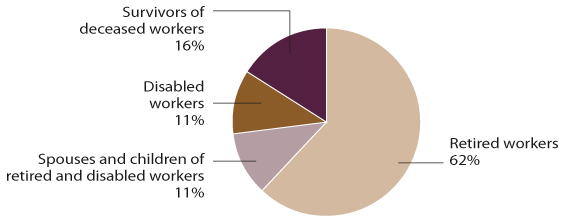
Benefit Amounts
Average amount of newly awarded benefits and benefits in current-payment status, 1999
Benefits payable to workers who retire at the normal retirement age and to disabled workers are equal to 100% of the PIA (subject to any applicable deductions). At the normal retirement age, widows benefits are also payable at 100% of the insured worker's PIA. Nondisabled widows and widowers can receive reduced benefits at age 60. Disabled widow benefits are payable (with a greater reduction) at age 50. Spouses, children, and parents receive smaller proportions of the worker's PIA than widows do.
| Type of beneficiary | New awards |
Current- payment amount |
|---|---|---|
| Retired workers | 795 | 804 |
| Spouses | 338 | 411 |
| Children | 351 | 373 |
| Disabled workers | 783 | 754 |
| Spouses | 207 | 189 |
| Children | 212 | 216 |
| Survivors | ||
| Nondisabled widows and widowers | 715 | 775 |
| Disabled widows and widowers | 502 | 500 |
| Widowed mothers and fathers | 569 | 566 |
| Surviving children | 539 | 526 |
| Parents | 688 | 674 |
Benefit Amounts
Hypothetical benefit amounts, 2000
A covered worker who had worked continuously at low wages (45% of average national wages) and who claimed benefits at age 62 in January 2000 would have received a monthly benefit of $518. One who had earnings at or above the maximum amount subject to Social Security taxes and who claimed benefits at age 65 would have received $1,433.
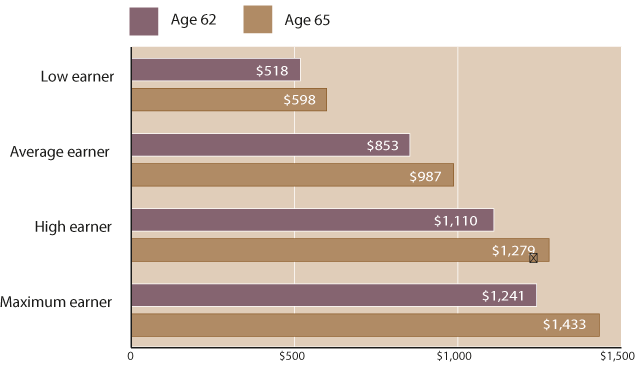
| Earnings | Age 62 | Age 65 |
|---|---|---|
| Low earner | 518 | 598 |
| Average earner | 853 | 987 |
| High earner | 1,110 | 1,279 |
| Maximum earner | 1,241 | 1,433 |
Beneficiaries by Age
Age of persons receiving benefits, December 1999
Some 81% of all OASDI beneficiaries with benefits in current-payment status were aged 62 or older in December 1999. Among OASI beneficiaries, 93% were 62 or older. Among DI beneficiaries (disabled workers and their spouses and children), most were under age 62.
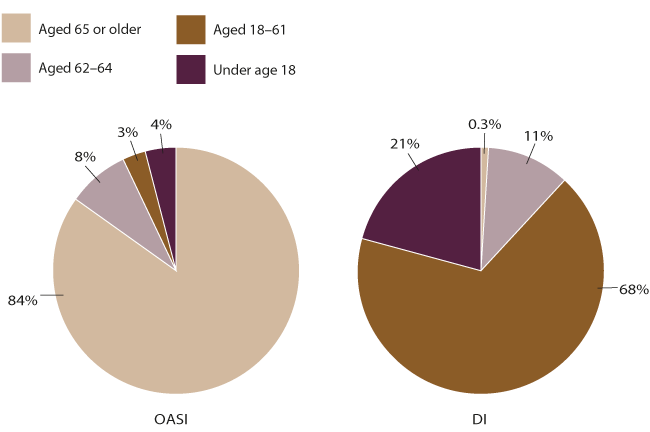
| Age | OASI | DI |
|---|---|---|
| Under 18 | 4 | 21 |
| 18–61 | 3 | 68 |
| 62–64 | 8 | 11 |
| 65 or older | 84 | 0.3 |
Beneficiaries by Age
Age of disabled-worker beneficiaries, 1960–99
The average age of disabled-worker beneficiaries in current-payment status has declined substantially since 1960, when DI benefits first became available to persons younger than age 50. In that year, the average age of a disabled worker was 57.2 years. By 1980, it had fallen to 53.2, and in 1999, the average age was 50.6 years.
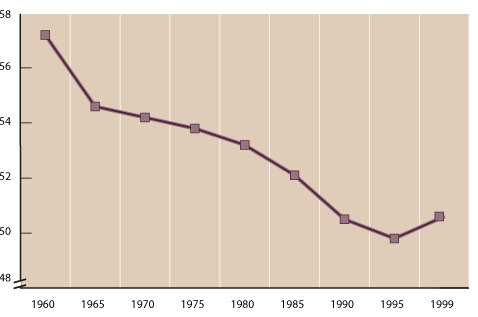
| Year | Disabled workers |
|---|---|
| 1960 | 57.2 |
| 1965 | 54.7 |
| 1970 | 54.2 |
| 1975 | 53.8 |
| 1980 | 53.2 |
| 1985 | 52.1 |
| 1990 | 50.5 |
| 1995 | 49.8 |
| 1999 | 50.6 |
Beneficiaries by Sex
Sex of persons receiving monthly benefits, December 1999
Of all adults receiving monthly Social Security benefits at the end of 1999, 42% were men and 58% were women. More than 80% of the men and more than 55% of the women received retired-worker benefits. Slightly less than one-fourth of the women received survivors benefits.
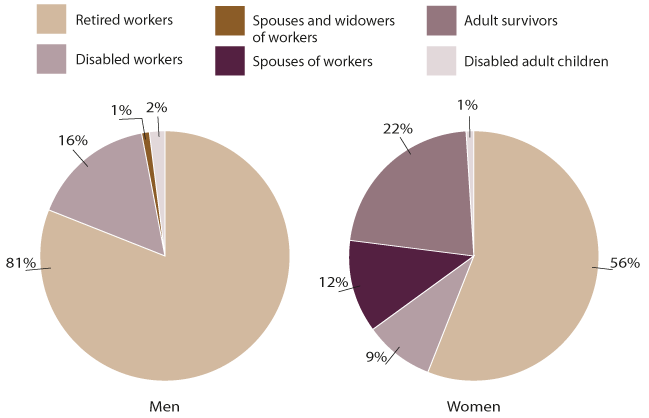
| Type of beneficiary | Men | Women |
|---|---|---|
| Retired workers | 81 | 56 |
| Disabled workers | 16 | 9 |
| Spouses of workers | a | 12 |
| Spouses and widowers of workers | 1 | a |
| Adult survivors | a | 22 |
| Disabled adult children | 2 | 1 |
| a. Less than 0.5 percent. | ||
Beneficiaries by Sex
Average monthly benefit amounts, December 1999
Among retired and disabled workers who collected benefits based on their own work record, men received a higher average monthly benefit than women. For those who collected benefits based on another person's work record (spouses and survivors), women had higher average benefits.
| Type of beneficiary | Men | Women |
|---|---|---|
| Total | 884 | 665 |
| Retired workers | 905 | 698 |
| Spouses | 235 | 413 |
| Disabled workers | 846 | 630 |
| Spouses | 145 | 190 |
| Survivors | ||
| Nondisabled widows and widowers | 572 | 776 |
| Disabled widows and widowers | 340 | 504 |
| Mothers and fathers | 474 | 570 |
Beneficiaries by Sex
Women-worker beneficiaries, 1940–99
The proportion of women among retired-worker beneficiaries has quadrupled since 1940. The proportion of women among disabled-worker beneficiaries has more than doubled since 1957, when benefits first became payable to disabled workers.
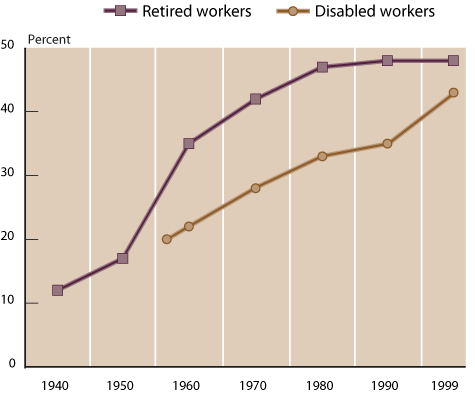
| Year | Retired workers |
Disabled workers |
|---|---|---|
| 1940 | 11.6 | -- |
| 1950 | 17.1 | -- |
| 1957 | -- | 19.1 |
| 1960 | 35.3 | 21.8 |
| 1970 | 42.4 | 28.4 |
| 1980 | 46.5 | 32.6 |
| 1990 | 47.7 | 34.0 |
| 1999 | 48.4 | 42.5 |
| NOTE: -- = not available. | ||
Dual Entitlement
Dual entitlement, 1960–99
The proportion of women aged 62 or older who are receiving benefits as dependents (that is, on the basis of their husband's earnings record only) has been declining—from 57% in 1960 to 35% in 1999. At the same time, the proportion of women with dual entitlement (that is, paid on the basis of both their own earnings record and that of their husband) has been increasing—from 5% in 1960 to 27% in 1999.
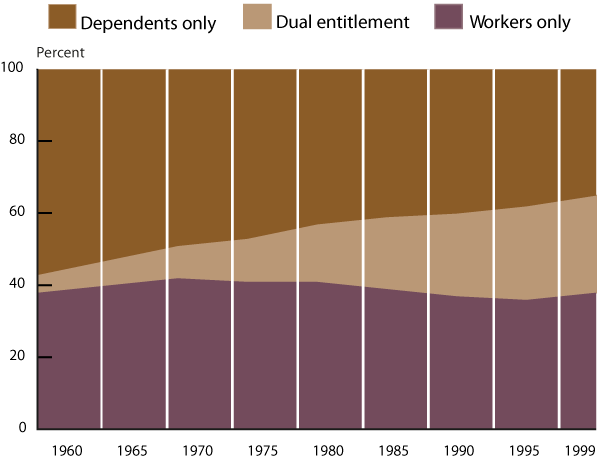
SSI Program
Recipients
Historical comparison, by age, 1974–99
Shortly after the SSI program began in 1974, the number of persons receiving federally administered payments rose to 4 million. It remained at about that level until the mid-1980s, then rose through the mid-1990s. In 1999, it stood at nearly 6.6 million.
| December | Total number (in thousands) |
|---|---|
| 1974 | 3,216 |
| 1976 | 4,326 |
| 1978 | 4,217 |
| 1980 | 4,142 |
| 1982 | 3,858 |
| 1984 | 4,029 |
| 1986 | 4,269 |
| 1988 | 4,464 |
| 1990 | 4,817 |
| 1992 | 5,566 |
| 1994 | 6,296 |
| 1996 | 6,614 |
| 1998 | 6,566 |
| 1999 | 6,557 |
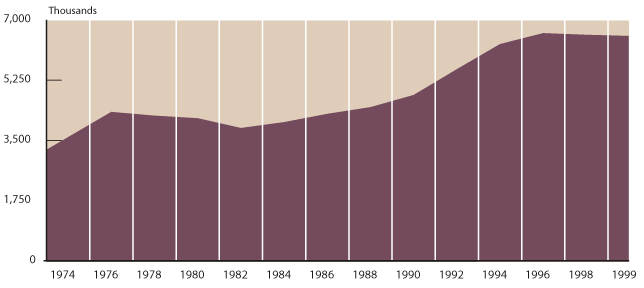
Payment Amounts
Average monthly payments, by age group, December 1999
The average federally administered SSI payment was $369 in December 1999. Payments varied by age group, ranging from an average of $450 for those under 18 to $293 for recipients aged 65 or older.
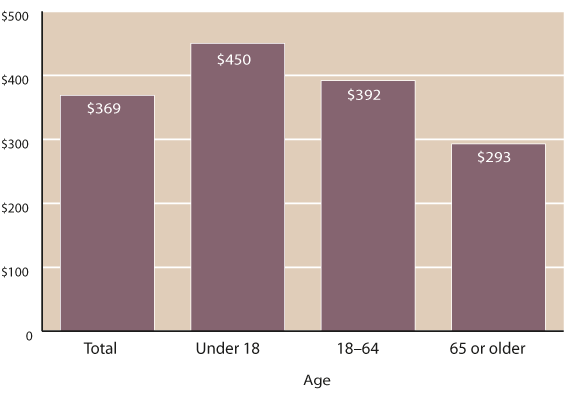
Federally Administered Payments
Recipients by type of payment, December 1999
Over 6 million persons received federally administered SSI payments in December 1999. Most received federal SSI only. States have the option of supplementing the federal benefit rate and are required to do so if that rate does not equal the income the recipient would have had under the former state program.
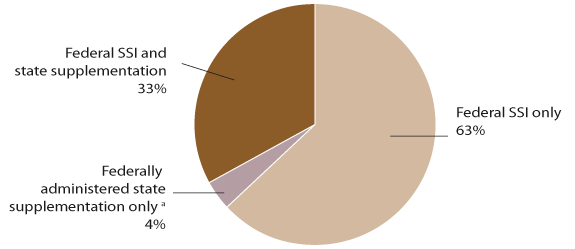
Basis for Eligibility
Recipients by basis for eligibility and age, December 1999
One-fifth of SSI recipients have been awarded benefits on the basis of age; most of the rest on the basis of disability. One-third of the recipients were aged 65 or older. In the SSI program—unlike the OASDI program—a disabled recipient can be aged 65 or older. (DI beneficiaries are converted to the retirement program when they attain age 65.)
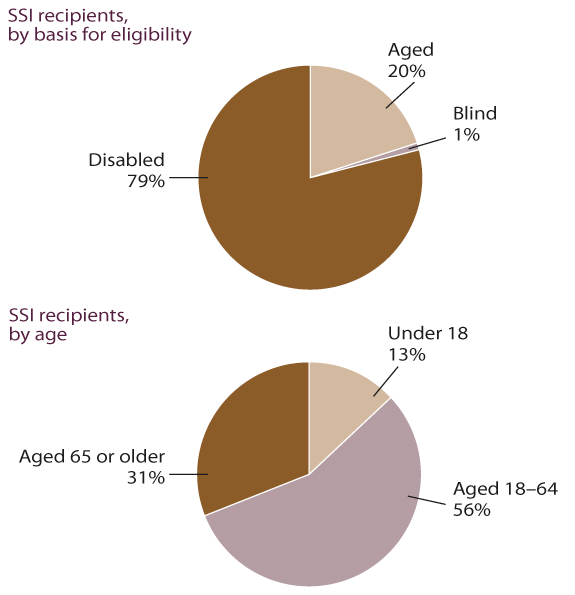
Recipients by Age
Historical comparison, by age, 1974–99
The proportion of SSI recipients aged 65 or older has declined from 61% in January 1974 to 31% in December 1999. The long-term growth of the SSI program has occurred because of an increase in the number of disabled recipients, most of whom are under age 65.
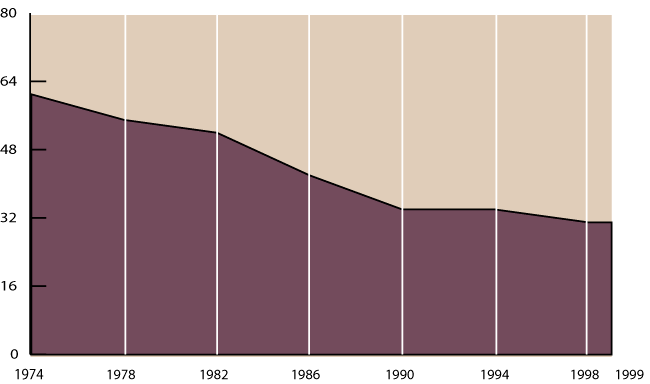
Recipients by Sex and Age
Distribution by sex and age, December 1999
Overall, 59% of the SSI recipients in December 1999 were women, but this varied by age group. Women accounted for nearly three-fourths of recipients aged 65 or older, over half of those aged 18–64, and over a third of those under age 18.
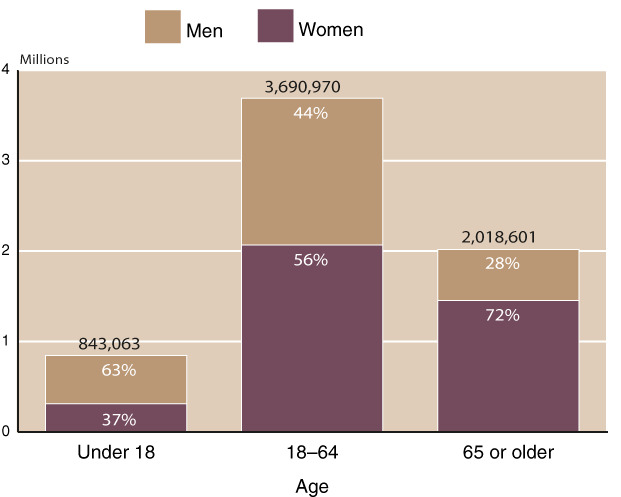
| Age | Men | Women |
|---|---|---|
| Under 18 | 63 | 37 |
| 18–64 | 44 | 56 |
| 65 or older | 28 | 72 |
Other Income
Type of other income received, December 1999
Nearly two-thirds of aged SSI recipients received OASDI benefits in December 1999, as did about one-third of those aged 18–64 and 7% of those under age 18. Other types of unearned income, such as veterans' pensions or income from assets, also occurred most frequently among those aged 65 or older (16%), while earned income was most prevalent (7%) among those 18–64.
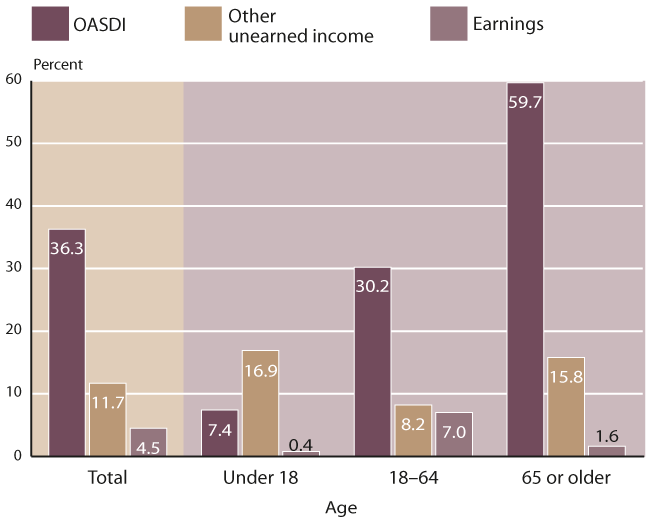
| Age | OASDI | Other unearned income |
Earnings |
|---|---|---|---|
| All ages | 36.3 | 11.7 | 4.5 |
| Under 18 | 7.4 | 16.9 | 0.4 |
| 18–64 | 30.2 | 8.2 | 7.0 |
| 65 or older | 59.7 | 15.8 | 1.6 |
OASDI and/or SSI
All Beneficiaries
Receipt of OASDI and SSI payments, December 1999
More than 48 million persons received a payment from Social Security in December 1999. Most (42.2 million) received OASDI benefits only; about 4.2 million received SSI only; and 2.4 million received payments from both programs.
| Type of beneficiary | Number (in thousands) |
|---|---|
| Total receiving OASDI and/or SSI | 48,770 |
| Total receiving OASDI | 44,596 |
| Receiving OASDI only | 42,213 |
| Total receiving SSI | 6,557 |
| Total receiving SSI only | 4,173 |
| Receiving both OASDI and SSI | 2,383 |

Beneficiaries Aged 65 or Older
Receipt of OASI and/or SSI aged benefits, December 1999
Aged or survivors benefits were paid to 32.9 million persons aged 65 or older in December 1999. About 1.2 million of them received both OASI and SSI.
| Type of beneficiary | Number (in thousands) |
|---|---|
| Aged 65 or older, total (unduplicated) | 32,938 |
| OASI total a | 32,125 |
| Retired workers | 25,304 |
| Spouses | 2,474 |
| Nondisabled widow(er)s | 4,280 |
| Disabled adult children aged 65 or older | 63 |
| SSI total b | 2,019 |
| Receiving SSI only | 813 |
| Concurrently receiving both OASI and SSI | 1,206 |
| a. Total includes 4,800 persons who received either dependent parents benefits, special age-72 benefits, or mothers/fathers benefits. | |
| b. Includes 710,600 disabled and blind SSI recipients aged 65 or older. | |
Disabled Beneficiaries
Receipt of disability payments, December 1999
Payments based on the beneficiary's own disability were made to 9.1 million persons under age 65 in December 1999. About 37% of them received payments from the SSI program only, 50% received payments from the OASDI program only, and 13% received payments from both programs.
| Type of payment | Number (in thousands) |
|---|---|
| Total receiving OASDI and/or SSI | 9,097 |
| OASDI disability | 5,736 |
| Disabled workers | 4,879 |
| Disabled children aged 18–64 | 658 |
| Disabled widow(er)s | 199 |
| OASDI disability only | 4,559 |
| SSI disability a | 4,538 |
| Blind and disabled aged 18-64 | 3,691 |
| Blind and disabled under age 18 | 847 |
| SSI disability only | 3,361 |
| Both OASDI and SSI | 1,177 |
| a. Total excludes 710,600 disabled and blind SSI beneficiaries aged 65 or older. | |

Children and Social Security
Children and OASDI
Current receipt, December 1999
Over 3 million children under age 18 and students aged 18–19 received OASDI benefits in December 1999—about half of them as the children of deceased workers. These children had the highest average payments, in part because they are eligible to receive monthly benefits equal to 75% of the worker's PIA, whereas the children of retired or disabled workers may receive 50%. Overall, the average monthly benefit amount for children was $363.
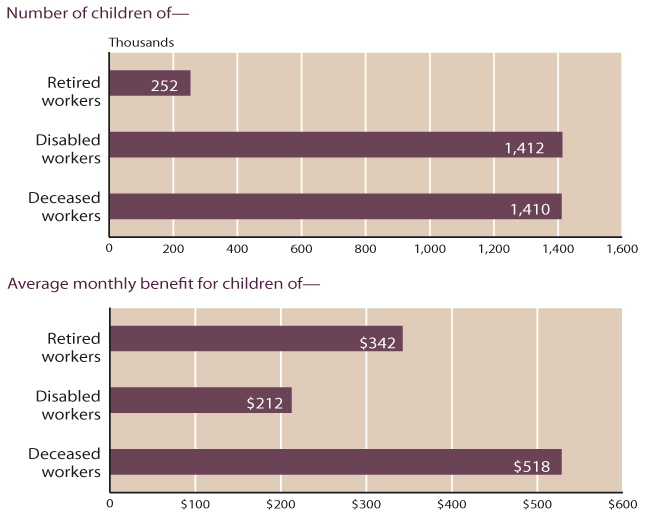
| Type of beneficiary | Number (thousands) |
Average monthly benefit (dollars) |
|---|---|---|
| Children of retired workers | 252 | 342 |
| Children of disabled workers | 1,412 | 212 |
| Children of deceased workers | 1,410 | 518 |
Children and SSI
Recipients and payment amounts, 1974–99
In 1974 when the program began, there were 70,900 blind and disabled children receiving payments under SSI. Since then, that number has increased ten-fold. The relatively high average payment to children (compared with those made to blind and disabled adults) is due in part to a limited amount of other countable income. The peak in average monthly benefits in 1992 is due to retroactive payments resulting from the Sullivan v. Zebley decision.
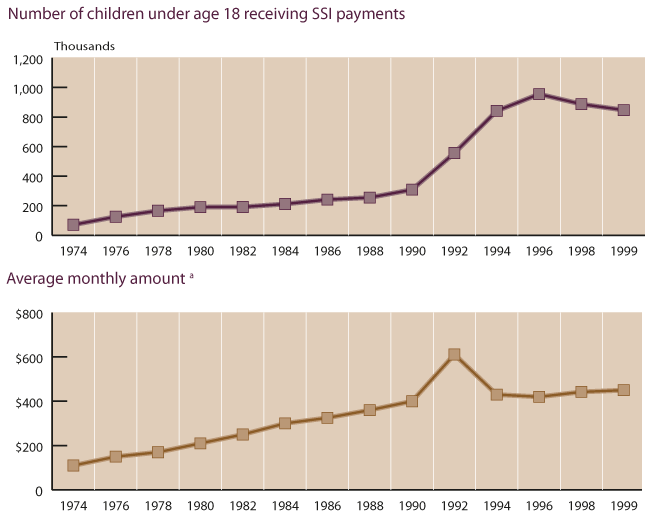
| Year | Number of children receiving SSI (in thousands) |
Average monthly SSI payment (in percent) a |
|---|---|---|
| 1974 | 70.90 | 109.15 |
| 1975 | 107.03 | 141.09 |
| 1976 | 125.41 | 154.24 |
| 1977 | 147.36 | 170.03 |
| 1978 | 165.90 | 171.72 |
| 1979 | 177.31 | 193.26 |
| 1980 | 190.39 | 219.08 |
| 1981 | 194.89 | 240.84 |
| 1982 | 191.57 | 263.22 |
| 1983 | 198.32 | 280.96 |
| 1984 | 211.59 | 292.86 |
| 1985 | 227.38 | 301.26 |
| 1986 | 241.20 | 321.34 |
| 1987 | 250.90 | 327.27 |
| 1988 | 255.14 | 343.24 |
| 1989 | 264.89 | 357.64 |
| 1990 | 308.59 | 403.72 |
| 1991 | 397.16 | 446.05 |
| 1992 | 556.47 | 610.98 |
| 1993 | 722.68 | 460.54 |
| 1994 | 841.47 | 448.07 |
| 1995 | 917.05 | 447.57 |
| 1996 | 955.17 | 442.01 |
| 1997 | 879.83 | 433.83 |
| 1998 | 887.07 | 441.75 |
| 1999 | 847.06 | 450.13 |
| a. As of 1998, these figures exclude retroactive payments. | ||
SSA's Role in Reducing Poverty
Social Security's role in reducing poverty for children
In 1998, 7 million children were living in families receiving OASDI and/or SSI benefits. About 1.1 million children would have resided in families with incomes below the poverty line without these benefits. About 2.3 million children were still poor even though OASDI and SSI benefits improved their situation.
